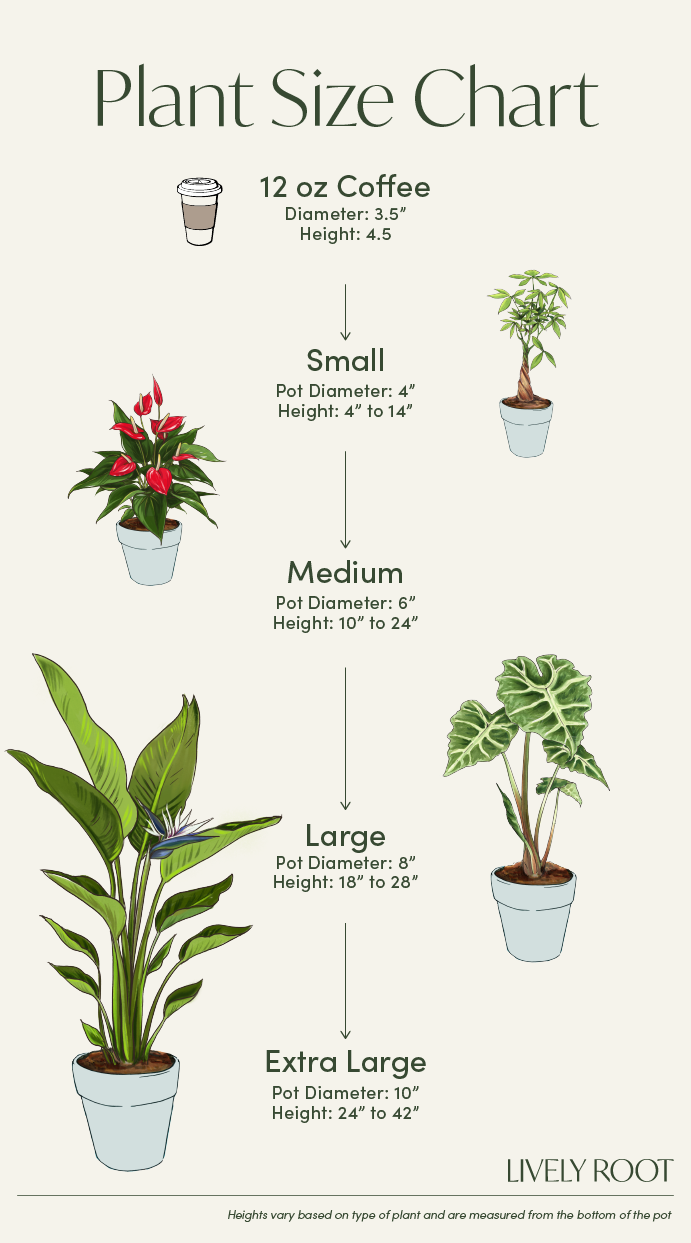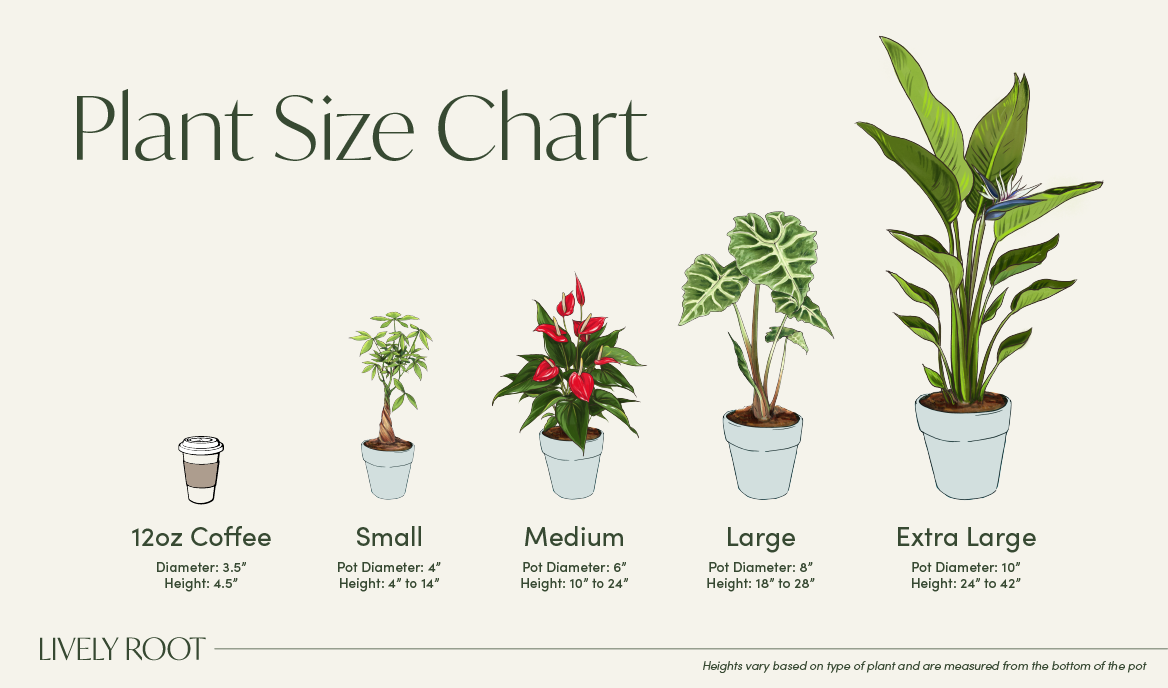

Red Poinsettia Care & Buying Guide

Indoors: Bright, indirect light. Outdoors: Partial sun on a patio where nights are above 65°F.
Water weekly when top 1-2 inches of soil are dry
Add a gravel tray, or use a humidifier or group with other plants. Spritz daily.
Average comfortable room temperatures will be sufficient. These plants do not like cold temperatures under 60°F. Avoid cold drafts or the leaves will exfoliate in protest.
Take outside where temperatures stay above 65°F at night. They can live in a part sun (4-6 hours) location on a patio in warmer climates.
No fertilizer is needed for your Poinsettia during the holiday season. As new green leaves emerge, then start the monthly process. Apply a balanced fertilizer throughout the growing season. After Labor Day, reduce your recommended strength of fertilizer by one-fourth. Back off on the fertilization schedule after the bracts have turned colors to prolong the color.
When receiving the plant, do not repot immediately but wait at least 6-12 months. When the plant is ready to repot (late spring or early summer), plant in a 2" bigger container in diameter and slightly deeper than the existing container. Use an indoor container mix that is well-draining and amended with peat moss and perlite. Add soil to the bottom to elevate the root ball. Tenderly lift the plant and release the roots against the existing planter. Use a clean knife or garden trowel to wedge between the pot and the soil to loosen. Inspect the root ball. Notice if there are any dead or rotting roots and trim off with sterile pruners. If the plant was rootbound, cut through the roots to alleviate continued encircling. Ensure the plant is sitting about 1" below the edge of the pot to avoid water spillage. Add more soil and backfill around the sides by tamping down. Do not cover the current level of soil on the plant but add soil up to this level. Replant and water thoroughly, leaving the soil damp but not soggy. Add more soil after watering if the soil settles. Hydrate the leaves with filtered water by spritzing. Your plant may wilt at first from transplanting but will recover shortly.
If your plant has grown and become too leggy, it's time to trim! Cut the stems back (using gloves to avoid the milky sap from irritating your skin) to five inches tall to promote leafy growth. Each month, continue to prune away any dead or fading leaves from the plant and keep the soil surface clean. Keep trimming throughout the season to promote leafier growth.
To propagate, take cuttings between 3-4 inches long with 3-4 leaves. These cuttings should be from new growth since the holiday season and not old colored leaves. Insert the stem in water, then rooting hormone, and place in a well-draining moist potting mix. Place a clear plastic bag over the container to keep things damp and humid while the cutting roots. Place the cutting in warm, bright, indirect light. Within a month, the root system should be developed.
Red Christmas Flower (Poinsettia): Overview
The Christmas Poinsettia, scientifically known as Euphorbia pulcherrima, is a vibrant holiday favorite. It is instantly recognizable by its striking red “flowers,” which are actually specialized leaves called bracts. Native to Mexico, the Red Red Poinsettias thrive in USDA hardiness zones 9-11 and prefer bright, indirect sunlight. These tropical plants are moderately easy to care for and symbolize celebration, success, and holiday cheer.
Though beautiful, Poinsettias are mildly toxic to pets and should be kept out of their reach. This holiday plant’s name comes from Joel Poinsett, the first US ambassador to Mexico, who introduced the plant to the United States. Poinsettias hold a special meaning and are an iconic staple in holiday decor, cherished for their eye-catching beauty and festive appearance.
Poinsettia: Benefits
- An easy-care plant, ideal for novice plant parents
- As an air-purifying plant, it removes toxins from indoor air
- A great gift plant for the holidays
- It has an aesthetic appeal that enhances any festive decor
- The perfect Christmas flower decoration
Red Poinsettia: Common Names
- Christmas Flower
- Christmas Star
- Lobster flower
- Mexican Flameleaf
- Painted Leaf
Poinsettia Plant Care Guide
The Poinsettia is a relatively low-maintenance plant, perfect for adding vibrant color during the holiday season. With the right care, it can thrive and maintain its signature red leaves. Here’s how to care for your poinsettia to keep it healthy and beautiful.
Watering and Humidity
Water your poinsettia when the top inch of soil feels dry. Do not overwater, as this can lead to root rot. Maintain moderate humidity levels to help the plant flourish. A room humidifier can assist during dry winter months.
Light and Temperature
Poinsettias need bright, indirect light to keep their leaves vibrant and encourage blooming. Direct sunlight should be avoided as it can scorch the leaves. Ideal temperatures range between 65°F to 80°F during the day, with slightly cooler nights. These plants do not like temperatures below 60°F.
Soil and Repotting
Plant your Red Christmas Flower in well-draining soil, such as a mix of potting soil with added sand or perlite for drainage. Repotting is usually not necessary unless keeping it beyond the holiday season. If so, choose a pot that accommodates growth; change the soil annually.
Feeding and Propagation
When it's not blooming, feed the Red Poinsettia plant monthly with a balanced liquid fertilizer. Poinsettias can be propagated from cuttings in late spring or early summer, ensuring you use healthy stems for successful rooting.
Common Problems and Maintenance
If your Poinsettia’s leaves don’t turn red, this could be due to insufficient nighttime darkness. Place the plant in complete darkness for 12-14 hours per day for at least eight weeks leading up to the holiday season. Regularly clean the leaves with a damp cloth to remove dust and keep them healthy. Watch for signs of leaf drop or wilting, which could indicate overwatering or drafts.
Red Poinsettia (Christmas Flower): Placement, Companion & Alternative Plants
The vibrant Red Poinsettia Flower is a classic holiday staple that brings festive cheer to any space. Whether used as a statement piece or part of a larger holiday display, it adds warmth and color during the holiday season.
Best Locations & Uses
- Perfect for your living room decor, complementing Christmas centerpieces or candle ring displays
- Adds festive decor to office desks and reception areas
- This Christmas flower is ideal for entryways to create a welcoming holiday atmosphere
- Suitable for novice plant enthusiasts due to easy care needs
- Makes an excellent holiday gift plant for friends or family
Companion Plants
For a harmonious holiday display, consider pairing your Red Poinsettia with other festive plants:
- Rosemary Christmas Tree (Rosmarinus officinalis): The Rosemary Christmas Tree is charming and fragrant, adding a touch of greenery that can be decorated with lights or ornaments.
- Aglaonema Red Siam (Aglaonema commutatum ‘Red Siam’): Aglaonema Red Siam’s striking red and green foliage complements the poinsettia’s vibrant hues perfectly.
- Baby Blue Eucalyptus (Eucalyptus pulverulenta ‘Baby Blue’): The Baby Bue Eucalyptus adds a refreshing scent and soft blue-green foliage, enhancing the holiday ambiance.
Alternative Plants
If you’re looking for pet-friendly alternatives to the Red Poinsettia, consider these vibrant holiday options:
- Red Lip Moth Orchid (Phalaenopsis spp.): The Red Lip Moth Orchid is a stunning flower that brings elegance and a pop of color to any holiday setting.
- Pink Christmas Cactus (Schlumbergera bridgesii): The Pink Christmas Cactus is an eye-catching succulent with beautiful pink blooms, perfect for festive decor.
- Red Christmas Cactus (Schlumbergera bridggesii): The Red Christmas Cactus offers rich red flowers that bloom throughout the season, adding warmth and charm to your space.
Get a Gorgeous Red Poinsettia This Christmas From Lively Root
Bring home the timeless beauty of a Poinsettia this holiday season from Lively Root and make your celebrations truly special.








































